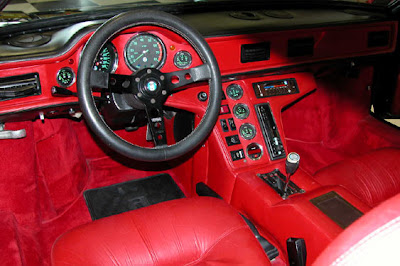THRUST MACHINES is an automobile based firm which provides modifications for classics and new generation vehicles, and the main purpose of gathering the concerned people on hub.
Monday, January 17, 2011
DETOMASO ARRIVES
detomaso historyAlejandro De Tomaso was born in Buenos Aires on 10th July 1928. His father was an eminent politician, who had been appointed minister of agriculture in the thirties; his *** belonged to one of the oldest Hispanic families originally controlled Argentinian agriculture.
According to the founder's narration, the symbol of De Tomaso stands for the iron tool used to brand horses in his 'estancia', while its colours are those of Argentinian flag. When Alejandro interrupted his studies, he already foresaw his destiny: he would have devoted his life to automobiles. At the age of 27 he arrived in Modena, the right place for racing a Maserati car in 1955/56 and for the famous constructor Osca in the three following seasons.
However, he felt he needed a change, so in 1959 Alejandro De Tomaso founded his own automobile company. The assembly facilities were built in Albareto, a suburb of Modena, just a few miles from the present plant.
Followed by a project for Indianapolis, among the first cars manufactured we find a Formula Junior and a F1car, powered by a flat counterposed 8 cylinders, designed by Engineer Massimino. After they had given their factory 'Officine Alfieri Maserati' to Orsi family, Maserati Bros founded their new activity for racing cars called Osca, which Mr. De Tomaso was very set. As a consequence of this business relationship, in 1962 Osca supplied De Tomaso with two engines, a 1100 cc and a 2000 cc with two camshaft, that were used for sport 'Barchetta' models.
In October 1963 De Tomaso became well-known to the public rolling out at Turin Motorshow the spider 'Vallelunga', equipped with a central backbone chassis, which is the same peculiarity we can find in other DeTomaso products, such as 'Mangusta', 'Guara`', and in Lotus Elan and Alpine A110 as well. 56 'Vallelunga' were built, many of them took part in races, thus obtaining remarkable successes.
Anyway, central chassis remains an important goal in De Tomaso history, and somehow it seems to be the real brand of this 'estancia' in Modena. Equpped with a Ford 5000 cc-V8 engine, 'P-70' was introduced at Turin Motorshow in 1965. However, this sport prototype was more an exercise of style than a pure racing car, and it participated in a few races. In 1966 De Tomaso presented in Geneva an 8 cylinder-2000 cc barchetta, penned by Giorgetto Giugiaro, who in 1965 started working at Ghia. Ghia became a De Tomaso possession in 1967.
Thanks to the fruitful cooperation between De Tomaso and Giugiaro in 1966, people could admire the aggressive styling of the first 'Mangusta' at Turin Motorshow. Two models of 'Mangusta' were sold: on the one hand, the European version with 4728 cc-306 Hp, and on the other, the version for America (4949 cc-230 Hp), where 280 manufactured vehicles were delivered. It was an unforeseen success, that led Ford to take over 80 per cent of De Tomaso S.p.A. shares.
Designed by the American stylist Tom Tjaarda, the new sedan 'Pantera', ordered by Ford, could boast many versions: 3000 cc called '290', 5700 cc GT4, and also 350 Hp GTS. Up to that moment, nobody reached the same amount of cars produced in Modena. In 1972 De Tomaso was second at Gran Turismo championship, thanks to Mike Parkers and Clay Regazzoni's racesses in Imola and Hockenheim respectively. Races have always been of primary importance for De Tomaso company, not only to win, but also to test how good its ideas and, cars were.
However, the participation in Formula 1 in 1970 was an exception. De Tomaso took part with only one vehicle, a red racing car with typical De Tomaso colours on the top. At that time, Project Leader was Giampaolo Dallara, the same man who today is in charge of the production of 80 per cent of vehicles that race in Indianapolis and of many other categories, while Frank Williams played the role of Team Manager and owner. But unfortunately, during the fourth race the 28 year-old English driver, Piers Courage, had an accident and died in Zanvoord on June 21st. Because of this tragedy, Alejandro seemed not to be attracted by Formula 1 project and races in general any longer.
In 1972 Ford acquired even Ghia and Vignale, where Panteras were manufactured, and the whole shares were took over again. In the meanwhile, De Tomaso built Deauville and Longchamp, and purchased Benelli. Just three years later, Alejandro succeeded in acquiring Maserati. The following year together with Gepi he took over Innocenti, which built the new model of English Mini, designed by the famous stylist Bertone. On 10th July 1981 De Tomaso concluded an agreement with Daihatsu for 100.000 engines, thus giving birth to a very important relationship, which led to the production of 120.000 vehicles.
Subscribe to:
Post Comments (Atom)








No comments:
Post a Comment